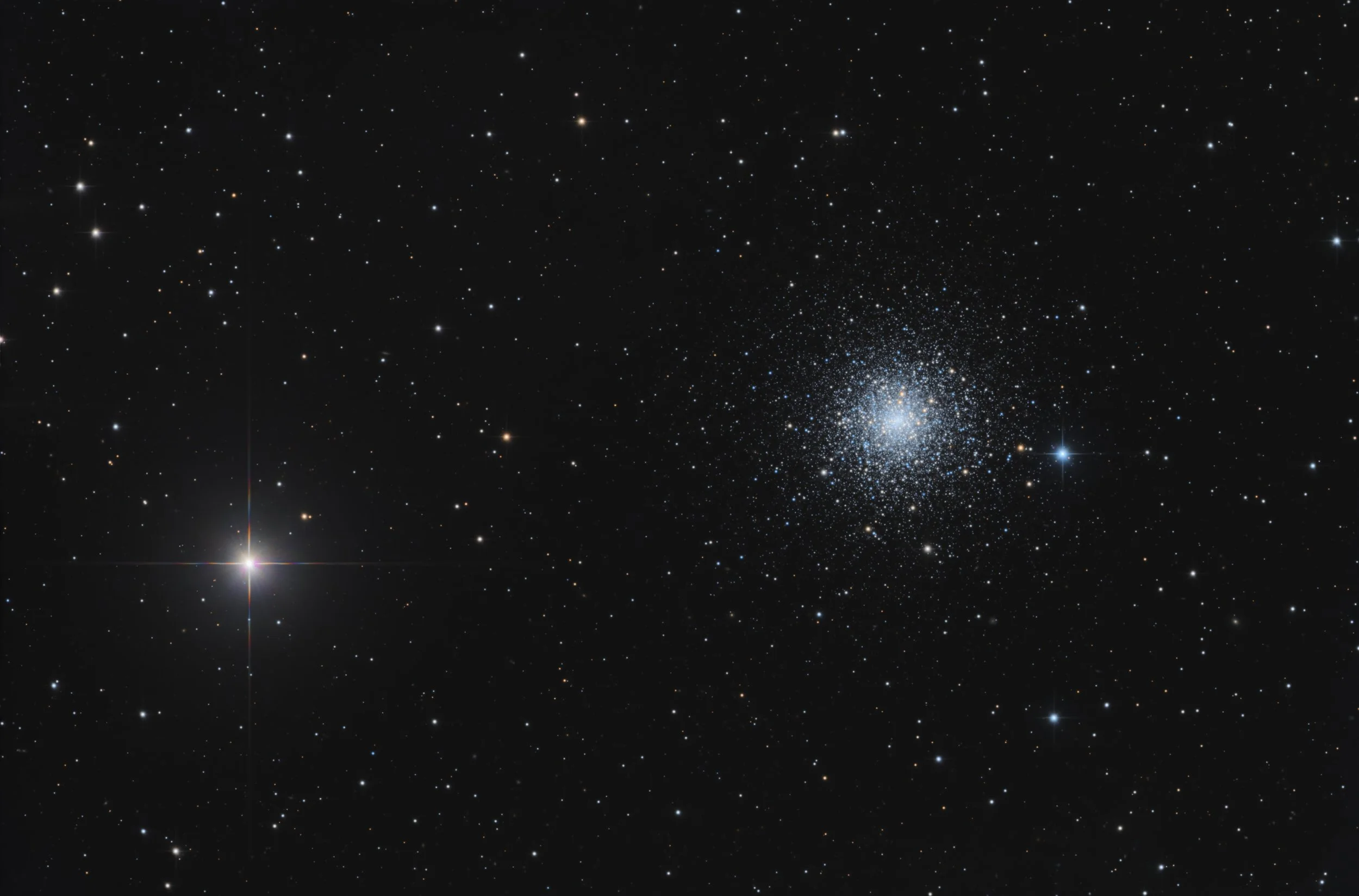M30
NGC 7099, Jellyfish cluster
47’ x 31’ | 0.3”/px | 9456 × 6236 px | full resolution
Capricornus
RA 21h 40m 55s Dec -23° 11’ 46” | 0°



Messier 30 (also known as NGC 7099 or the Jellyfish Cluster) is a globular cluster in the southeast of the southern constellation of Capricornus. It was discovered by the French astronomer Charles Messier in 1764, who described it as a circular nebula without a star. In the New General Catalogue, compiled during the 1880s, it was described as a "remarkable globular, bright, large, slightly oval." M30 is centred 27,100 light-years away from Earth and is about 93 light-years across. The estimated age is roughly 12.9 billion years and it forms a mass of about 160,000 times the mass of the Sun (M☉). The cluster is following a retrograde orbit (against the general flow) through the inner galactic halo, suggesting that it was acquired from a satellite galaxy rather than forming within the Milky Way. It is in this epoch 22.2 kly from the center of the galaxy, compared to an estimated 26 kly for the Sun. The cluster has passed through a dynamic process called core collapse and now has a concentration of mass at its core of about a million times the Sun's mass per cubic parsec. This makes it one of the highest density regions in the Milky Way galaxy. Stars in such close proximity will experience a high rate of interactions that can create binary star systems, as well as a type of star called a blue straggler that is formed by mass transfer. A process of mass segregation may have caused the central region to gain a greater proportion of higher mass stars, creating a color gradient with increasing blueness toward the middle of the cluster.
The large star on the left of the image is 41 Capricorni. This is a binary star system in the southern constellation of Capricornus with an apparent magnitude of 5.24. It is around 171 light years away from us, so much closer than the cluster. And it is moving closer with a heliocentric radial velocity of −45 km/s. This is a yellow K-type giant star with a stellar classification of K0 III. At the age of around 550 million years it has become a red clump star, which indicates it is generating energy via helium fusion at its core. It has an estimated 2.55 times the mass of the Sun and is radiating 48 times the Sun's luminosity. The magnitude 11.5 companion lies at an angular separation of 5.5″, as of 2008. The star is so bright relative to the cluster, that it made a nice composition together with M30. Therefore in targeting the cluster it was purposely placed off-center.
source: Wikipedia (M30), Wikipedia (41Cap)
Data Acquisition
Data was collected over 4 nights in August and September 2025, using a 14” reflector telescope with full-frame camera at the remote observatory in Spain. Data was gathered using standard RGB filters. A total of approximately 10 hours of data was finally combined to create the final image.
Location Remote hosting facility IC Astronomy in Oria, Spain (37°N 2°W)
Sessions
Frames
Equipment
Telescope
Mount
Camera
Filters
Guiding
Accessoires
Software
Planewave CDK14 (2563mm @ f/7.2), Optec Gemini Rotating focuser
10Micron GM2000HPS, custom pier
Moravian C3-61000 Pro (full frame), cooled to -10 ºC
Chroma 2” RGB unmounted, Moravian filterwheel L, 7-position
Unguided
Compulab Tensor I-22, Dragonfly, Pegasus Ultimate Powerbox v2
Voyager Advanced, Viking, Mountwizzard4, Astroplanner, PixInsight 1.9.3
Processing
All processing was done in Pixsinsight unless stated otherwise. Default features were enhanced using scripts and tools from RC-Astro, SetiAstro, GraXpert, CosmicPhotons and others. Images were calibrated using 50 Darks, 50 Flats, and 50 Flat-Darks, registered and integrated using WeightedBatchPreProcessing (WBPP). The processing workflow diagram below outlines the steps taken to create the final image.
The more I use the GeneralisedHyperbolicStretch (GHS) tool, the more I discover what it can do. By playing around with the symmetry point, local intensity and stretch factor, subtle changes can be made. And additional options enhance the usability a great extent. Working in (blended) colour mode prevents colour from washing out during stretching. Applying an inverse curve can secure better dynamic range. The linear transformation type has automatic black point detection. In addition, I found that applying small adjustments multiple times works a lot more forgiving than trying to get everything right in one or two runs. And with these options available in one tool, there is less need for tools like ArcSinhstretch, HistogramTransformation or CurvesTransformation. They all have their place, and I definitely use them, but GHS often gets 90% of the way there. The automatic tools such as PMUI scriplet Smart Stretch or SetiAstro script Statistical stretch are easy to use of course and can give very good results as well, but if you want or need more control, GHS is a very versatile option. For this particular image I have not used CurvesTransformation or HIstogramTransformation a single time, which is quite unusual for my processing workflow.
After stretching was complete, I found the blue colours a bit overwhelming and the reds a bit subdued. Probably a consequence of colour calibration with S0 galaxy as the reference, and a full 100% colour blend during GHS stretching, which for an RGB-only image without a separate Lum channel is a bit too much. I could have gone back and re-done it all, but decided to use a quick ColorSaturation correction for both the blues and the reds.
The rest of the processing workflow followed regular procedures.
Processing workflow (click to enlarge)
This image has been published on Astrobin.
